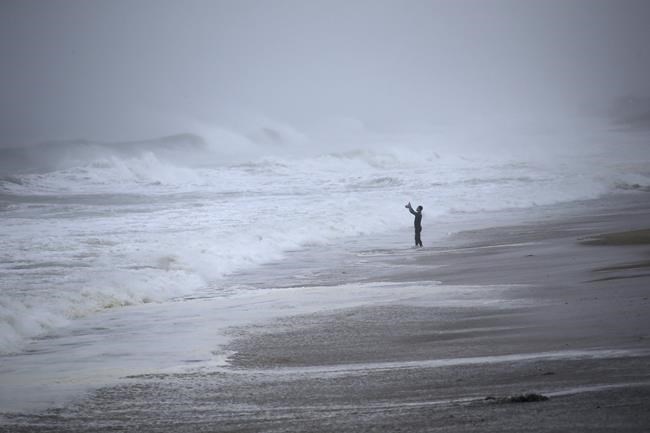WESTERLY, R.I. (AP) — Tropical Storm Henri hit the coast of Rhode Island Sunday afternoon, packing high winds that knocked out power to tens of thousands of homes and bands of rain that led to flash flooding from New Jersey to Massachusetts.
The storm was downgraded from a hurricane to a tropical storm, but still packed wind gusts of up to 70 mph. There were few early reports of major damage due to wind or surf, but officials warned of the danger of spot flooding in inland areas over the next few days.
Millions on New York’s Long Island and in southern New England braced for the possibility of flooding, toppled trees and extended power outages. Residents up and down the coast hoped to be spared the storm’s wrath but prepared for the worst.
Driving surf and sheets of rain scoured the beach towns of southern Rhode Island as the storm approached, leaving some coastal roads nearly impassable. Some small trees had already fallen to the winds and rain, which had swollen local inlets and creeks.
Westerly resident Collette Chisholm, a 20-year resident, said the waves were much higher than normal, but said she wasn’t concerned about her home suffering extensive damage.
“I love storms,” she said. “I think they’re exciting, as long as no one gets hurt.”
In Newport, Paul and Cherie Saunders were riding out the storm in a home that her family has owned since the late 1950s. Their basement flooded with 5 feet of water during Superstorm Sandy nine years ago.
“This house has been through so many hurricanes and so many things have happened,” said Cherie Saunders, 68. “We’re just going to wait and see what happens.”
Farther south in Branford, Connecticut, 61-year-old geologist Paul Muniz was busy securing his boat in anticipation of the storm. Muniz lives close to the marina and has survived previous storms, and spent $50,000 to elevate his home 9 feet off the ground.
“I’ve lived here for 32 years, had an opportunity to move a number of times, but you know, it’s a very special place,” Muniz said.
While the wind was significant in certain areas, experts warned that the storm’s biggest threat likely will come from storm surge and inland flooding, caused by what are expected to be heavy and sustained rains. Some of the highest rain totals were expected inland.
In one of his final appearances as governor before he is set to step down at the end of Monday over a sexual harassment scandal, New York Gov. Andrew Cuomo said that with the threat to Long Island diminishing, the state’s primary concern were inland areas like the Hudson River Valley, north of New York City, which was projected to get inches of rain over the next few days.
Rainfall in the Catskills “is a significant problem,” Cuomo said. “In the Hudson Valley you have hills, you have creeks, the water comes running down those hills and turns a creek into a ravaging river. I have seen small towns in these mountainous areas devastated by rain. That is still a very real possibility.”
Troy Buckner of Southampton, in eastern Long Island’s Hamptons, wouldn’t let the storm interrupt his near-daily routine of getting coffee with his dad at the Golden Pear, one of the few spots open on Main Street Sunday morning.
“Today we thought we’d still try to keep a little bit of normalcy, but we’re heading back home for the remainder,” Buckner said as the rain pelted down. “We plan for the worst. You just never know. We always anticipate Southampton could be the center, the bull’s eye.”
A lack of major roadways on the eastern end of Long Island makes mass evacuations untenable, East Hampton Mayor Jerry Larsen said.
“We have one lane of travel leaving the Hamptons so it’s a little difficult to order evacuations,” Larsen told The Associated Press. “So most people will shelter in place and, God willing, everyone will come through this OK.”
In preparation for the storm, officials in Providence, Rhode Island, and New Bedford, Massachusetts, closed giant hurricane barriers that were built in the 1960s, after devastating storms in 1938 and 1954.
Massachusetts’ Steamship Authority canceled all Sunday ferry service between the mainland and the popular vacation islands of Martha’s Vineyard and Nantucket after the U.S. Coast Guard shut down ports on Cape Cod and New Bedford. Tourists waiting in their cars, hoping for a last-minute ferry off the islands, were stranded until the worst of Henri passes.
The first thunderstorms bringing what could be up to half a foot (15 centimeters) of rain arrived late Saturday, and flash flooding began in some areas overnight. Bands of heavy rain overwhelmed storm drains and drivers plowed through foot-deep water in a few spots in New York City, and Newark and Hoboken, New Jersey.
President Joe Biden declared disasters in much of the region, opening the purse strings for federal recovery aid. The White House said Biden discussed preparations with northeastern governors and that New York Lt. Gov. Kathy Hochul, who succeeds Cuomo on Tuesday, also participated.
Major airports in the region remained open as the storm approached, though hundreds of Sunday’s flights were canceled. Service on some branches of New York City’s commuter rail system was suspended through Sunday, as was Amtrak service between New York and Boston.
New York hasn’t had a direct hit from a powerful cyclone since Superstorm Sandy wreaked havoc in 2012. Some of the most important repairs from that storm have been completed, but many projects designed to protect against future storms remain unfinished.
___
Kunzelman reported from Newport, Rhode Island. Porter reported from New York. Associated Press writers William J. Kole in Warwick, Rhode Island, Michelle Smith in Providence, Rhode Island, Julie Walker in East Hampton, Ted Shaffrey in Branford, Connecticut, and Mike Melia in Hartford, Connecticut contributed to this report.
David Klepper, Michael Kunzelman And David Porter, The Associated Press
